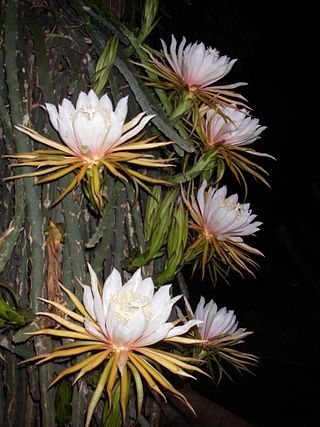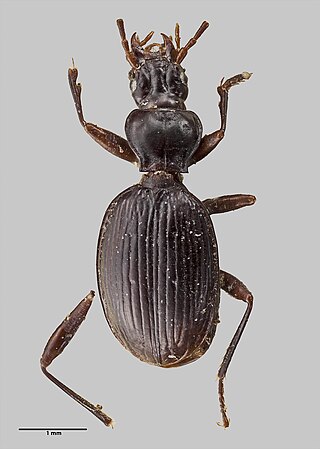
Tabebuia is a genus of flowering plants in the family Bignoniaceae. Tabebuia consists almost entirely of trees, but a few are often large shrubs. A few species produce timber, but the genus is mostly known for those that are cultivated as flowering trees.

Abutilon is a large genus of flowering plants in the mallow family, Malvaceae. It is distributed throughout the tropics and subtropics of the Americas, Africa, Asia, and Australia. General common names include Indian mallow and velvetleaf; ornamental varieties may be known as room maple, parlor maple, or flowering maple. The genus name is an 18th-century Neo-Latin word that came from the Arabic ’abū-ṭīlūn, the name given by Avicenna to this or a similar genus.

Thespesia is a genus of 14 flowering shrubs and trees in the Hibiscus family, Malvaceae, although within the family they are more closely related to cotton plants (Gossypium). The genus is distributed from the South Pacific through Asia, Africa, and the Caribbean.

Plumeria, also known as frangipani, is a genus of flowering plants in the subfamily Rauvolfioideae, of the family Apocynaceae. Most species are deciduous shrubs or small trees. The species are native to the Neotropical realm, but are often grown as cosmopolitan ornamentals in tropical regions, especially in Hawaii, as well as hot desert climates in the Arabian Peninsula with proper irrigation.

Acanthocereus is a genus of cacti. Its species take the form of shrubs with arching or climbing stems up to several meters in height. The generic name is derived from the Greek word άκανθα (acantha), meaning spine, and the Latin word cereus, meaning candle. The genus is native to the mostly tropical Americas from Texas and the southern tip of Florida to the northern part of South America, including islands of the Caribbean.

Schlumbergera is a small genus of cacti with six to nine species found in the coastal mountains of south-eastern Brazil. These plants grow on trees or rocks in habitats that are generally shady with high humidity, and can be quite different in appearance from their desert-dwelling cousins. Most species of Schlumbergera have stems which resemble leaf-like pads joined one to the other and flowers which appear from areoles at the joints and tips of the stems. Two species have cylindrical stems more similar to other cacti.

Hylocereus is a former genus of epiphytic cacti, often referred to as night-blooming cactus. Several species previously placed in the genus have large edible fruits, which are known as pitayas, pitahayas or dragonfruits. In 2017, a molecular phylogenetic study confirmed an earlier finding that the genus Hylocereus was nested within Selenicereus, so all the species of Hylocereus were transferred to Selenicereus.

Mila caespitosa is a species of cacti and the only species of the genus Mila. Its generic name is an anagram of Lima, Peru, the city near which the plant is found. The genus was first thought to comprise 13 species, until recent studies suggest they form one very variable species.

Pereskiopsis is a genus of cactus in the subfamily Opuntioideae. Unlike typical cacti, it has persistent fleshy leaves. The genus name refers to its resemblance to the genus Pereskia. Most species are found in Mexico south through Guatemala to Honduras, with one species in Bolivia. The incorrect spelling Peireskiopsis has also been used.

Melolonthinae is a subfamily of the scarab beetles. It is a very diverse group; distributed over most of the world, it contains over 11,000 species in over 750 genera. Some authors include the scarab subfamilies Euchirinae and Pachypodinae as tribes in the Melolonthinae.

Chloroleucon is a genus of flowering plants in the family Fabaceae. It contains 11 species native to the tropical Americas, ranging from Mexico through Central America, the Caribbean, and South America to northern Argentina. Some authorities consider it part of the genus Albizia. Its name is derived from the Greek words χλωρóς (chloros), meaning "green," and λευκός (leukos), meaning "white."

Elizabeth Gertrude Britton was an American botanist, bryologist, and educator. She and her husband, Nathaniel Lord Britton, played a significant role in the fundraising and creation of the New York Botanical Garden. She was a co-founder of the precursor body to the American Bryological and Lichenological Society. She was an activist for the protection of wildflowers, inspiring local chapter activities and the passage of legislation. Elizabeth Britton made major contributions to the literature of mosses, publishing 170 papers in that field.
Lebidema is a genus of beetles in the family Carabidae, containing the following species:
Lobodontus is a genus in the beetle family Carabidae. There are about 12 described species in Lobodontus, found in Africa.

Dasiosoma is a genus in the beetle family Carabidae. There are about 10 described species in Dasiosoma.

Aulacopodus is a genus of beetles in the family Carabidae, containing the following species:

Holcaspis is a genus of beetles in the family Carabidae, endemic to New Zealand.

Plocamostethus is a genus of beetles in the family Carabidae. It is endemic to New Zealand. The genus contains the following species:

Duvaliomimus is a genus in the beetle family Carabidae. There are about 13 described species in Duvaliomimus, found in New Zealand.
Henry Hurd Rusby (1855–1940) was an American botanist, pharmacist and explorer. He discovered several new species of plants and played a significant role in founding the New York Botanical Garden and developing research and exploration programs at the institution. He helped to establish the field of economic botany, and left a collection of research and published works in botany and pharmacology.
















